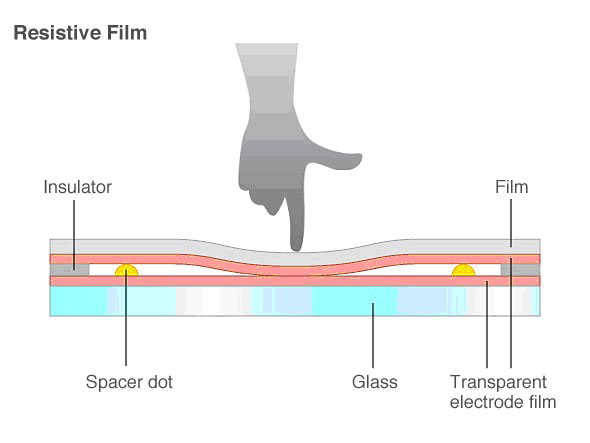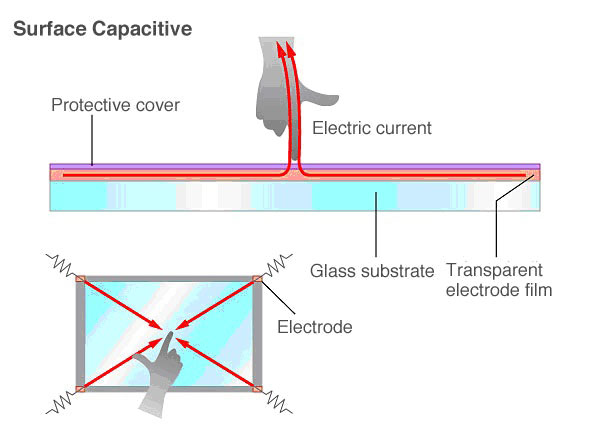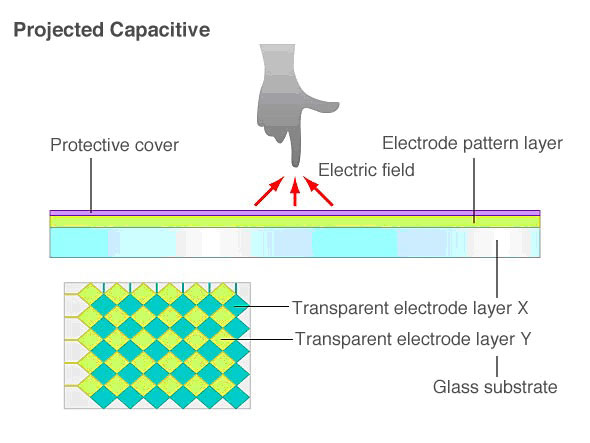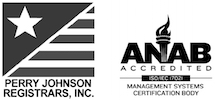Touch screens have become a very common part of our daily lives. Smartphones, handheld video games, car navigation systems, ticket vending machines, kiosks, bank ATMs, and more all use touch panels to enable users to interact with a computer or device without the use of a keyboard or mouse. Even though they are all touch screens, there are several uniquely different types of touch panels. The term touch panel incorporates varied technologies for sensing the touch of a finger or stylus. The most common types are resistive, surface capacitive, projected capacitive, surface acoustic wave, infrared optical imaging, and electromagnetic induction. This article will mainly focus on resistive, surface capacitive, and projected capacitive as these are the touch panels Acnodes Corporation primarily uses for the products.
A major factor influencing the widespread of touch panels is the benefit offered in the way of intuitive operation. They are easy to understand and easy to use even by people who are inexperienced with computers since they can be used for input through direct icons and buttons. Touch panels also contribute to miniaturizing and simplifying the devices by fusing display and input into a single piece of equipment. Since touch panels are software, not hardware, their interfaces can be easily changed through software. A touch panel requires a wide range of characteristics like precision in position sensing, rapid response to input, durability, installation costs, and most importantly display visibility, their characteristics vary significantly depending on the methods used to sense touch input. Below are the three common types of touch screens integrated into Acnodes' industrial monitors and displays.
Resistive Type Touch Screen

(Photo courtesy of http://www.eizoglobal.com)
The resistive film is the most widely used sensing method in the touch screen panel market. A resistive touch screen monitor is composed of a glass panel and a film screen, each covered with a thin metallic layer, separated by a narrow gap. When a user touches the screen, the two metallic layers come into contact, resulting in electrical flow. The point of contact is detected by this change in voltage. The front surface is scratch-resistant with a coating of a conductive material.
Advantages:
• Low production cost due to simple structure
• High resistance to surface contaminants and liquids (dust, oil, grease, moisture)
• Can be activated with virtually any object (finger, stylus, gloved hand, pen, etc.)
• Best suited for handwriting recognition
• Low power consumption
• Has a tactile feel
Disadvantages:
• Lower image clarity due to lower light transmittance
• Outer polyester film is vulnerable to damage from scratch
• Does not support multi-touch
Surface Capacitive Type Touch Screen

(Photo courtesy of http://www.eizoglobal.com)
The surface capacitive is the second most popular type of touch screen on the market. It is often used in relatively large panels. In a surface capacitive touch screen monitor, a transparent electrode layer is placed on top of a glass panel and covered by a protective cover. When an exposed finger touches the monitor screen, it reacts to the static electrical capacity of the human body; some of the electrical charges transfer from the screen to the user. This decrease in capacitance is detected by sensors located at the four corners of the screen, allowing the controller to determine the touchpoint. Capacitive touch screens can only be activated by the touch of human skin or stylus holding an electrical charge.
Advantages:
• Brighter and sharper image clarity
• Highly touch-sensitive, no need for a stylus
• Supports multi-touch
• Durable screen
• High scratch resistance
• Excellent resistance to surface contaminants and liquids (dust, oil, grease, water droplets)
Disadvantages:
• Sensitivity to EMI/RFI
Projected Capacitive Type Touch Screen

(Photo courtesy of http://www.eizoglobal.com)
Projected capacitive touch panels are often used for smaller screen sizes than capacitive touch panels. Smartphones and handheld devices use this method to accomplish high-precision multi-touch functionality and high response speed. Projected capacitive is similar to surface capacitive, but it offers two primary advantages: in addition to bare fingers, it can also be activated with surgical gloves or thin cotton gloves and it enables multi-touch activation. A project capacitive is composed of a sheet of glass with embedded transparent electrode films and an IC chip, which creates a three-dimensional electrostatic field. When a finger comes into contact with the screen, the ratios of the electrical currents change and the computer is able to detect the touchpoints.
Advantages:
• Excellent image clarity
• More resistant to scratching than surface capacitive
• Resistant to surface contaminants and liquids (dust, oil, grease, moisture)
• Multi-touch
• Highly touch-sensitive, activated via exposed finger, or thin surgical or cotton gloves
Disadvantages:
• Sensitivity to EMI/RFI
Overview of the Different Types of Touch Screen Technologies
 |
• Surface Capacitive Touch Screens - Surface Capacitive touch screens have a protective barrier to defend the screen from scratches and weakening. Even with the problems of spills, dents and abrasions, it sustains its maximum capabilities and maintains its functionality by remaining unaffected by demanding external environments. |
 |
• Secure Touch Surface Wave Touch screens - Secure Touch Surface Wave touch screens use exceptionally reliable and dependable glass for imitable picture and resolution quality. Made with all glass, this scratch resistant technology is suitable for environments with harsh conditions. |
 |
• AccuTouch Five-Wire Resistive Touch screens - AccuTouch technology qualifies as the most contaminant-resistant touch screen due to its ability to withstand and protect itself against moisture. Even under the toughest conditions such as including liquid spills, sprays, sprinkles, and splashes, this touch screen maintains its durability. |
 |
• CarrollTouch Infrared Touch screens - CarrollTouch Infrared touchscreen uses a choice of glass or acrylic overlay for protection, making it the optimal option for environments with critical surroundings. Because this is the only technology that does not depend on a substrate, the touchscreen works flawlessly even when used with a gloved hand. |
 |
• IntelliTouch Surface Wave Touch screens - Put together with pure glass, the IntelliTouch surface wave is state-of-the-art touchscreen technology making it the most scratch-resistant obtainable equipment out there. With its durable glass surface, it provides the utmost quality for image clarity, resolution, and light transmission. |
Surface Capacitive Touch Screens
What is it and how does it work?
Capacitive touch screens depend on our electric impulses for it to work. Depending on when and where touched, the human body sends signals to the screen. Capacitive touch screens cannot function if used with a stylus or a gloved hand, because of their reliance on the light touch of a finger. Surface Capacitive touch screens have a protective barrier to defend the screen from scratches and weakening. Even with the problems of spills, dents, and abrasions, it sustains its maximum capabilities and maintains its functionality by remaining unaffected by demanding external environments. Although this type of screen cannot function when using with a gloved hand, special application gloves with an embroidered patch of conductive threads are now available for more functionality. Most hand-held technologies use a capacitive touch screen because of its thin and more accurate sensor.
AccuTouch Five-Wire Resistive Touch Screens
What is it and how does it work?
The Accutouch Five-Wire Resistive touchscreen is composed of a glass panel with a resistive overlay plus a cover sheet with a conductive layer. This technology is essential due to its proficiency in stability and long product life. These are primarily used on voting machines, office retail mechanization, and medical industrialization. This type of screen is made from three different sheets: conductive, resistive, & a protective layer which is why it is so durable. Resistive touch screens are very common because it is affordable and generally has a longer life. The most important layers include two electrically resistive layers, which form a gap between each other. The part we touch, the outermost part of the screen, is called the protection layer which protects the screen from scratches, water spills, and other types of damage.
Secure Touch Surface Wave Touch Screens
What is it and how does it work?
The Secure Touch Surface Wave touch screen is made out of pure glass and has a scratch-resistant surface that can tolerate extreme physical wear and tear damage over time. This type of touch screen is used primarily in ATMs, amusement parks, kiosks, and banking applications. This screen has what’s called “X & Y axes” to convey and pick up piezoelectric transducers. This transducer device receives five-megahertz electrical signals which are modified into ultrasonic waves amidst the glass. When the screen is touched, a coordinate is calculated depending on how much of the signal is absorbed.
CarrollTouch Infrared Touch Screens
What is it and how does it work?
The CorrollTouch is ideal for brutal industrial applications and used predominantly in the hospital setting. Because of its vandal resistance capabilities, it is physically impossible to weaken the touch screen, making it the top-notch touch screen technology thus far. The touch screen technology allows the display to become viewable under the brightest luminance, including direct sunlight. This high-tech technology uses photoreceptors and LEDs to create IR light beams touched and is able to perform flawlessly even under extreme temperatures from -20ºC to 70ºC (operating temperature) to -40ºC to 85ºC (storage temperature).
IntelliTouch Surface Wave Touch Screens
What is it and how does it work?
The IntelliTouch Surface Wave touchscreen technology has a sensitive touch response that determines the location and amount of pressure applied and can be used with a gloved hand, stylus, or even a fingernail. It has a scratch-resistant surface, making it durable enough to withstand vandal environments while maintaining its functionality. This screen has what’s called “X & Y axes” to convey and pick up piezoelectric transducers. This transducer device receives five-megahertz electrical signals which are modified into ultrasonic waves amidst the glass. When the screen is touched, a coordinate is calculated depending on how much of the signal is absorbed.
Source: Pictures from elotouch




